Implementations of some theoretical generative adversarial nets: DCGAN, EBGAN, LSGAN, WGAN, WGAN-GP, BEGAN, DRAGAN and CoulombGAN.
I implemented the structure of model equal to the structure in paper and compared it on the CelebA dataset and LSUN dataset without cherry-picking.
- Model architectures are same as the architectures proposed in each paper
- Each model was not much tuned, so the results can be improved
- Well-structured (was my goal at the start, but I don't know whether it succeed!)
- TensorFlow queue runner is used for input pipeline
- Single trainer (and single evaluator) - multi model structure
- Logs in training and configuration are recorded on the TensorBoard
- DCGAN
- LSGAN
- WGAN
- WGAN-GP
- EBGAN
- BEGAN
- DRAGAN
- CoulombGAN
The family of conditional GANs are excluded (CGAN, acGAN, and so on).
http://mmlab.ie.cuhk.edu.hk/projects/CelebA.html
- All experiments were performed on 64x64 CelebA dataset
- The dataset has 202599 images
- 1 epoch consists of about 1.58k iterations for batch size 128
http://lsun.cs.princeton.edu/2017/
- The dataset has 3033042 images
- 1 epoch consists of about 23.7k iterations for batch size 128
This dataset is provided in LMDB format. https://github.com/fyu/lsun provides documentation and demo code to use it.
- I implemented the same as the proposed model in each paper, but ignored some details (or the paper did not describe details of model)
- Granted, a little details make great differences in the results due to the very unstable GAN training
- So if you had a better results, let me know the settings 🙂
- Default batch_size=128 and z_dim=100 (from DCGAN)
Radford, Alec, Luke Metz, and Soumith Chintala. "Unsupervised representation learning with deep convolutional generative adversarial networks." arXiv preprint arXiv:1511.06434 (2015).
- Relatively simple networks
- Learning rate for discriminator (D_lr) is 2e-4 and learning rate for generator (G_lr) is 2e-4 (proposed in the paper) and 1e-3
| G_lr=2e-4 | G_lr=1e-3 |
|---|---|
| 50k | 30k |
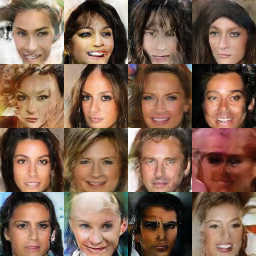 |
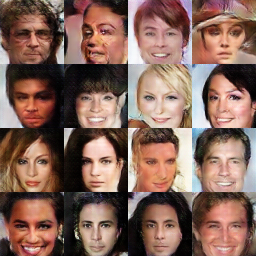 |
Second row (50k, 30k) indicates each training iteration.
Higher learning rate (1e-3) for generator made better results. In this case, however, the generator has been collapsed sometimes due to its large learning rate. Lowering both learning rate may bring stability like https://ajolicoeur.wordpress.com/cats/ in which suggested D_lr=5e-5 and G_lr=2e-4.
| LSUN |
|---|
| 100k |
 |
Zhao, Junbo, Michael Mathieu, and Yann LeCun. "Energy-based generative adversarial network." arXiv preprint arXiv:1609.03126 (2016).
- I like energy concept, so this paper is very interesting for me :)
- But there is criticism: Are Energy-Based GANs any more energy-based than normal GANs?
- Anyway, the energy concept and autoencoder based loss function are impressive, and the results are also fine
- But I have a question for Pulling-away Term (PT), which prevents mode-collapse theoretically. This is the same idea as minibatch discrimination (T. Salimans et al).
| pt weight = 0.1 | No pt loss |
|---|---|
| 30k | 30k |
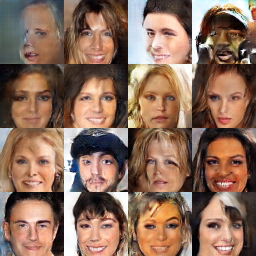 |
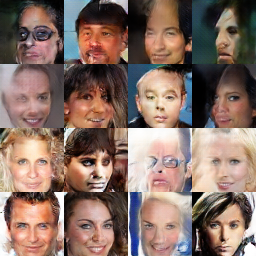 |
The model using PT generates slightly better sample visually. However, it is not clear from this results whether PT prevents mode-collapse. Furthermore, I could not distinguish what setting is better from repeated experiments.
| pt weight = 0.1 | No pt loss |
|---|---|
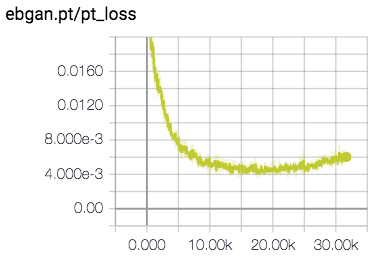 |
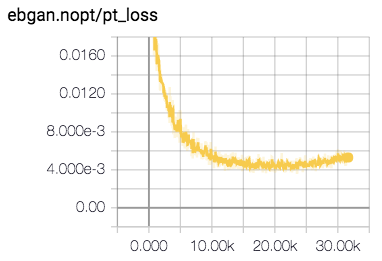 |
pt_loss decreases a little faster in the left which used pt_weight=0.1 but there is no big difference and even at the end the right which used no pt_loss showed a lower pt_loss. So I wonder: is the PT loss really working for preventing mode-collapse as described in the paper?
| LSUN |
|---|
| 80k |
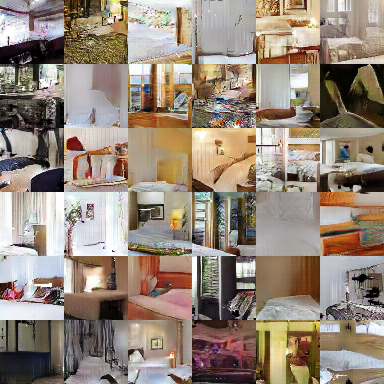 |
Mao, Xudong, et al. "Least squares generative adversarial networks." arXiv preprint ArXiv:1611.04076 (2016).
- Unusually, LSGAN used large latent space dimension (z_dim=1024)
- But in my experiment, z_dim=100 makes better results than z_dim=1024 which is originally used in paper
| z_dim=100 | z_dim=1024 |
|---|---|
| 30k | 30k |
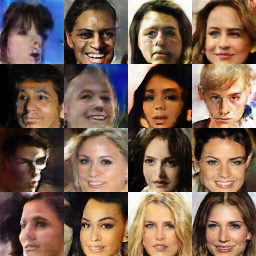 |
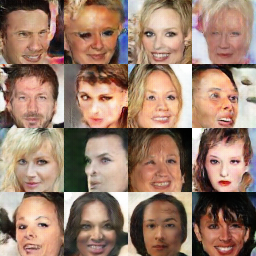 |
| LSUN |
|---|
| 150k |
 |
Arjovsky, Martin, Soumith Chintala, and Léon Bottou. "Wasserstein gan." arXiv preprint arXiv:1701.07875 (2017).
- The samples from WGAN are not that impressive - compared to the very impressive theory
- Also no specific network structure proposed, so DCGAN architecture was used for experiments
- In the author's implementation, they used higher n_critic in the early stage of training and per 500 iterations
| 30k | W distance |
|---|---|
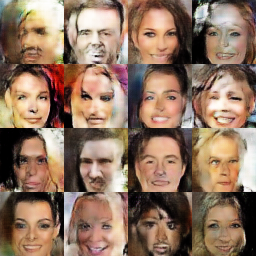 |
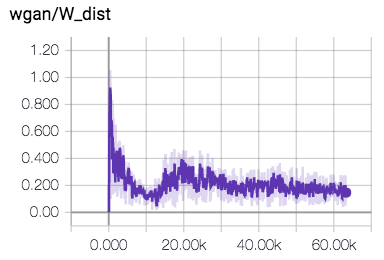 |
| LSUN |
|---|
| 230k |
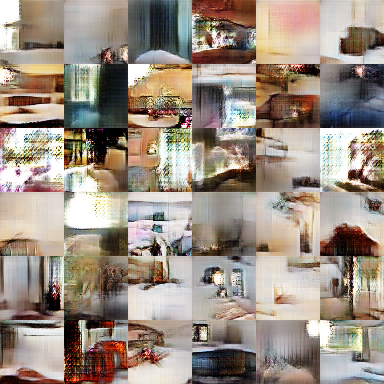 |
Gulrajani, Ishaan, et al. "Improved training of wasserstein gans." arXiv preprint arXiv:1704.00028 (2017).
- I tried two network architectures, which are DCGAN architecture and ResNet architecture in appendix C
- ResNet has more complicated architecture and better performance than DCGAN architecture
- The interesting thing is that the visual quality of samples improves very quickly (ResNet WGAN-GP has best samples on 7k iterations) and it gets worse when continue training
- According to DRAGAN, constraints of WGAN are too restrictive to learn good generator
| DCGAN architecture | ResNet architecture |
|---|---|
| 30k | 7k, batch size = 64 |
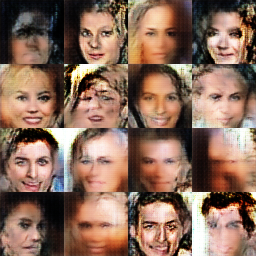 |
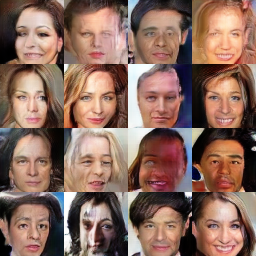 |
| LSUN |
|---|
| 100k, ResNet architecture |
 |
WGAN-GP was collapsed more than other models when the iteration increases.
DCGAN architecture
| 10k | 20k | 30k |
|---|---|---|
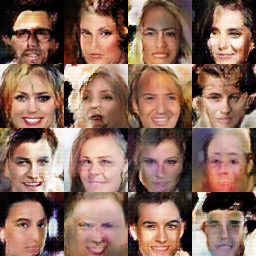 |
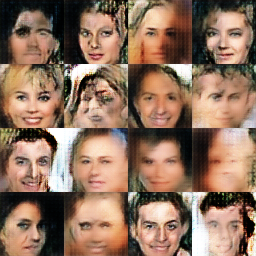 |
 |
ResNet architecture
ResNet architecture showed the best visual quality sample in the very early stage, 7k iteration in my criteria. This maybe due to the residual architecture.
batch_size=64.
| 5k | 7k | 10k | 15k |
|---|---|---|---|
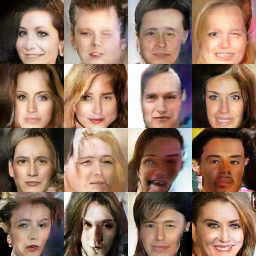 |
 |
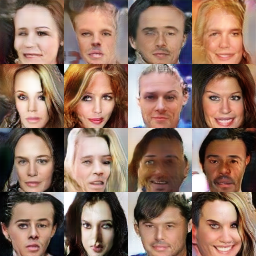 |
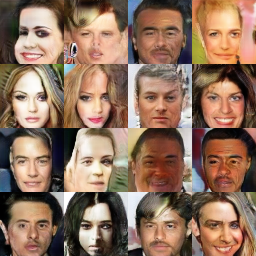 |
| 20k | 25k | 30k | 40k |
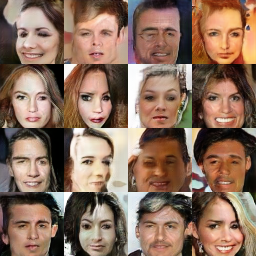 |
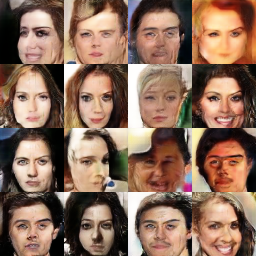 |
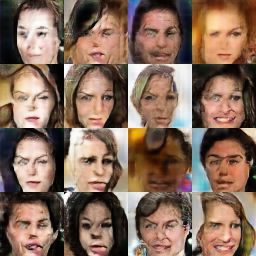 |
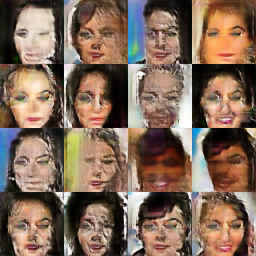 |
Regardless of the face collapse phenomenon, the Wasserstein distance decreased steadily. It should come from that the critic (discriminator) network failed to find the supremum and K-Lipschitz function.
| DCGAN architecture | ResNet architecture |
|---|---|
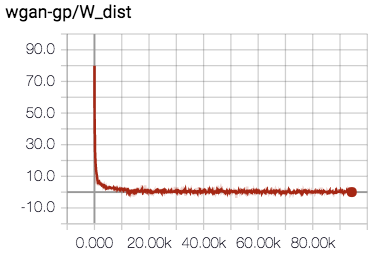 |
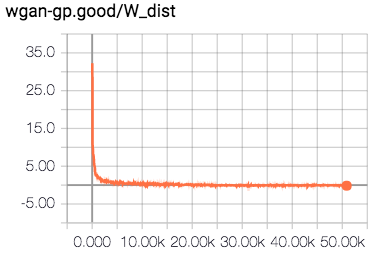 |
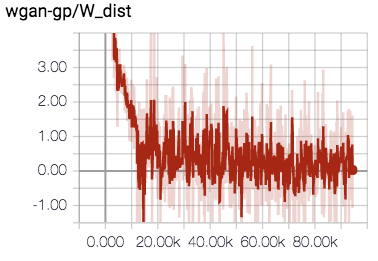 |
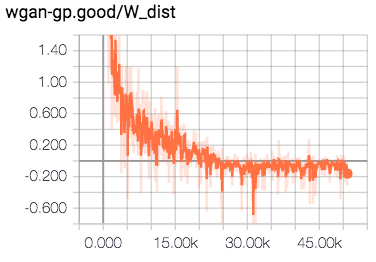 |
The plots in the last row of the table are just expanded version of the plots in the second row.
It is interesting that W_dist < 0 at the end of the training. This indicates that E[fake] > E[real] and, in the point of original GAN view, it means the generator dominates the discriminator.
Berthelot, David, Tom Schumm, and Luke Metz. "Began: Boundary equilibrium generative adversarial networks." arXiv preprint arXiv:1703.10717 (2017).
- The best model that generates samples with the best visual quality as far as I know
- It also showed the best performance in this project
- Even though optional improvements was not implemented (section 3.5.1 in the paper)
- However, the samples generated by BEGAN give a slightly different feel from other models - it seems like disappearing details.
- So I just wonder what the results are for different datasets
batch_size=16, z_dim=64, gamma=0.5.
| 30k | 50k | 75k |
|---|---|---|
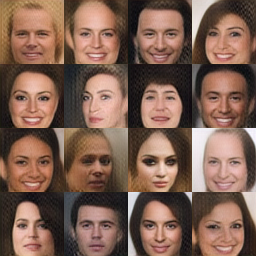 |
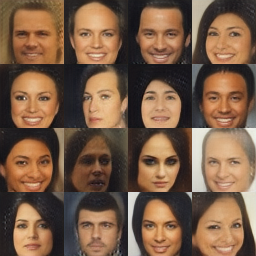 |
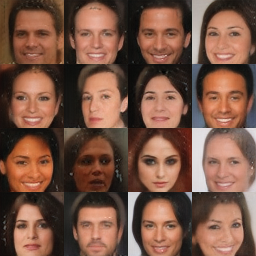 |
| Convergence measure M |
|---|
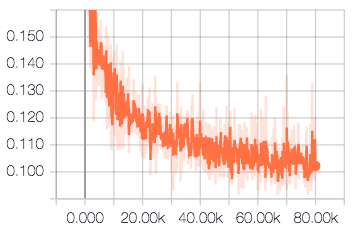 |
I also tried to reduce speck-like artifacts as suggested in Heumi/BEGAN-tensorflow, but it did not go away.
BEGAN in the LSUN datset works terribly. Not only severe mode-collapse was observed, but also generated images were not realistic.
| LSUN | LSUN |
|---|---|
| 100k | 150k |
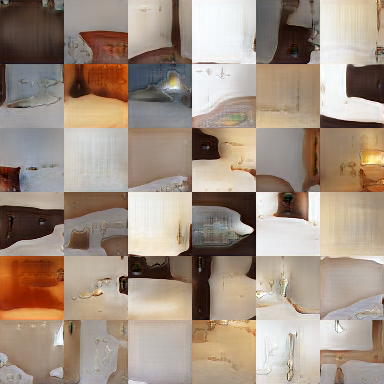 |
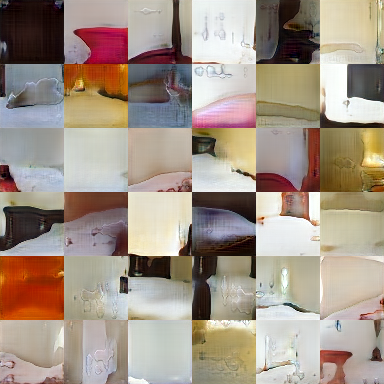 |
| 200k | 250k |
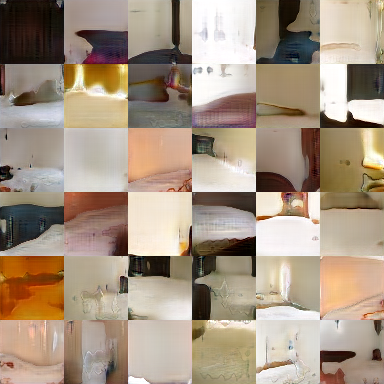 |
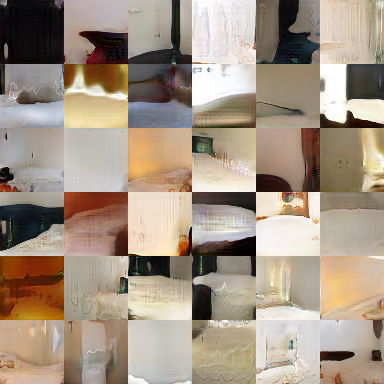 |
Kodali, Naveen, et al. "How to Train Your DRAGAN." arXiv preprint arXiv:1705.07215 (2017).
- Different with other papers, DRAGAN was motivated from the game theory for improving performance of GAN
- This approach through the game theory is highly unique and interesting
- But, IMHO, there is not much real contribution. The algorithm is similar to WGAN-GP
| DCGAN architecture |
|---|
| 120k |
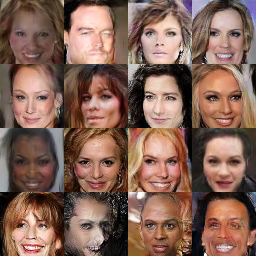 |
The original paper has some bugs. One of those is image x is pertured only positive-sided. I applied two-sided perturbation as the author admitted this bug on the GitHub.
| LSUN |
|---|
| 200k |
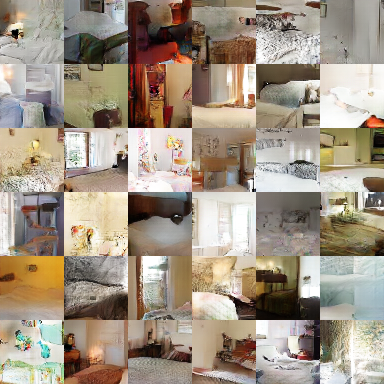 |
Unterthiner, Thomas, et al. "Coulomb GANs: Provably Optimal Nash Equilibria via Potential Fields." arXiv preprint arXiv:1708.08819 (2017).
- CoulombGAN has also very interesting perspective - "Coulomb potential".
- It is very interesting but I don't know whether it is GAN.
- CoulombGAN tried to solve the diversity problem (mode collapse)
G_lr=5e-4, D_lr=25e-5, z_dim=32.
| DCGAN architecture |
|---|
| 200k |
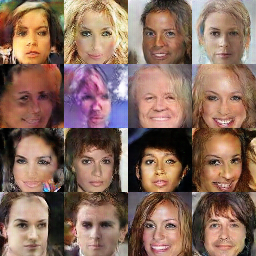 |
The disadvantage of this model is that it takes a very long time to train despite the simplicity of network architecture. Further, like original GAN, there is no convergence measure. I thought that the potentials of fake samples served as a convergence measure, but it did not.
Download CelebA dataset:
$ python download.py celebA
$ python download.py lsun
Convert images to tfrecords format:
Options for converting are hard-coded, so ensure to modify it before run convert.py. In particular, LSUN dataset is provided in LMDB format.
$ python convert.py
Train:
If you want to change the settings of each model, you must also modify code directly.
$ python train.py --help
usage: train.py [-h] [--num_epochs NUM_EPOCHS] [--batch_size BATCH_SIZE]
[--num_threads NUM_THREADS] --model MODEL [--name NAME]
--dataset DATASET [--ckpt_step CKPT_STEP] [--renew]
optional arguments:
-h, --help show this help message and exit
--num_epochs NUM_EPOCHS
default: 20
--batch_size BATCH_SIZE
default: 128
--num_threads NUM_THREADS
# of data read threads (default: 4)
--model MODEL DCGAN / LSGAN / WGAN / WGAN-GP / EBGAN / BEGAN /
DRAGAN / CoulombGAN
--name NAME default: name=model
--dataset DATASET, -D DATASET
CelebA / LSUN
--ckpt_step CKPT_STEP
# of steps for saving checkpoint (default: 5000)
--renew train model from scratch - clean saved checkpoints and
summaries
Monitor through TensorBoard:
$ tensorboard --logdir=summary/dataset/name
Evaluate (generate fake samples):
$ python eval.py --help
usage: eval.py [-h] --model MODEL [--name NAME] --dataset DATASET
[--sample_size SAMPLE_SIZE]
optional arguments:
-h, --help show this help message and exit
--model MODEL DCGAN / LSGAN / WGAN / WGAN-GP / EBGAN / BEGAN /
DRAGAN / CoulombGAN
--name NAME default: name=model
--dataset DATASET, -D DATASET
CelebA / LSUN
--sample_size SAMPLE_SIZE, -N SAMPLE_SIZE
# of samples. It should be a square number. (default:
16)
- python 2.7
- tensorflow >= 1.2 (verified on 1.2 and 1.3)
- tqdm
- (optional) pynvml - for automatic gpu selection